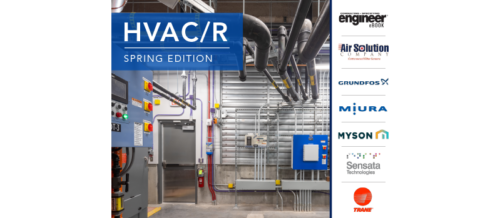Promoting Diversity—in VAV System
Editor's note: Your eyes are not deceiving you. In an effort to present more engineering fundamentals, we'll periodically run "CSE Classics." This story originally ran in Sept. 2000. Variable-air-volume (VAV) supply-air systems are usually designed so that the total air-handling unit (AHU) capacity (QAHU) is less than their total terminal-unit air volumes (ÓQTU).
Variable-air-volume (VAV) supply-air systems are usually designed so that the total air-handling unit (AHU) capacity (Q AHU ) is less than their total terminal-unit air volumes (ÓQ TU ). The ratio of these two numbers (Q AHU /ÓQ TU ) is called the air-handling system diversity , often expressed as a percentage.
VAV systems can be designed with diversities of less than unity because not all spaces in a building will peak—require full cooling—at the same time of a design day (see “Cooling Load: A Sample Analysis,” page 42).
To illustrate the concept of airflow diversity, Figure 1 shows an area of a building served by a static regain-designed supply ductwork system. The area shown is the south half of the first floor. The single AHU for the duct system, which serves the entire building, was selected for a total airflow capacity of 25 percent less than the sum of the building’s terminal-unit peak airflow volumes. This was done because the building’s cooling load diversity was calculated at 75 percent.
The supply trunk duct right at the AHU will never need to handle more than the AHU’s total airflow capacity. In other words, this duct segment will see the overall building cooling-load diversity. Similarly, duct segment “A” in Figure 1 will never need to convey more than the volume of air needed at any time by its service area—the south half of the first floor.
Based on the cooling load calculations, the block maximum equals 66 percent of the sum of the peak airflow requirements for all zones. Therefore, segment “A” can be sized one-third smaller than what would be indicated by adding up all of its downstream terminal-unit airflow volumes.
For each segment of trunk duct, the suitable degree of this apparent underlining changes as ducts branch off. Otherwise, there would be no difference in the airflow diversity between the AHU discharge and duct segment “A.” At each duct branch, succeeding duct trunks will see different degrees of airflow diversity, because the overall time/cooling load characteristics of the zones served by the remaining trunk ducts change as zone ducts branch off.
The change in diversity between trunk ducts upstream and downstream from any branch duct depends on the relative airflow volumes and relative times of day of cooling peaks between the branch and remaining trunk ducts.
For example, a 14-percent change in main-trunk duct airflow diversity is calculated at the point where branch duct 4 (serving a west perimeter zone) splits off, compared with the 3-percent change where branch duct 3 (which serves an interior zone) branches off.
Branch duct 4 has a fairly high cooling load, and hence, a high airflow that peaks at a time of day (6 p.m.) when the other downstream zones, served by terminal units 5 through 9, are well past their time of peak cooling need (11 a.m.). Branch duct 3 has a smaller airflow relative to the remaining downstream ductwork and its peak load occurs at the same time as the overall peak of the downstream zones (5 p.m.).
Ultimately, at the ends of the duct run (trunk “I” in Figure 1), there is only one downstream terminal unit. Trunk “I” must be sized to handle all of its downstream terminal unit’s airflow volume—a diversity of 100 percent.
The way the ductwork is routed, relative to the timing of the various load peaks, affects the degree of diversity that the duct trunks will experience. For example, because of the way in which the solar load shifts throughout the day, a trunk duct that serves both east and west perimeter zones experiences more diversity than one that serves only east, west, south or the internal zones.
Diversity simulation during commissioning
Nowadays, in the typical VAV system, the supply-fan speed varies in response to a signal from a static-pressure sensor, usually located approximately two-thirds of the way down the supply duct. The fan speed is controlled to maintain the duct’s static pressure at the sensor—at a programmed setpoint value—as supply-air terminal units open and close their dampers in response to the cooling needs of the spaces they serve. Determining a duct’s static-pressure setpoint value, as well as the appropriate sensor location, is the goal of the airflow diversity simulation. The proper setpoint value is the minimum static pressure needed to provide full airflow to all the individual zones as they peak at various times throughout a design day.
To accomplish this goal, the commissioning authority and the testing, adjusting and balancing (TAB) contractor must understand the interrelationship of diversity, duct routing and duct sizing. With this understanding, they can develop and execute test procedures to ensure adequate airflow to all building spaces under actual operating conditions—with minimum noise and energy consumption. Basically, the idea is to minimize the duct system static pressure that must be maintained while ensuring that all the zones get the air they need.
Air balance procedure
Figure 2 shows a section-view schematic of the sample office building. A single penthouse air-handling unit delivers supply air through a vertical duct to the three building floors. At each floor, there are two main horizontal trunk ducts: one goes to the north half of the floor, the other delivers air to the south half.
The TAB contractor’s first task is calibrating terminal units throughout the supply-air system in order to determine that the airflow volumes read from the temperature-control system are accurate. In performing this task, the contractor should also note any terminal units that have difficulty achieving their design airflow volumes so that the cause—poor fittings, duct obstructions—can be identified and corrected.
Once all problem terminal units are corrected and the computer can be trusted to provide accurate cubic-feet-per-minute values, the necessary static pressures at the main trunk branches (identified in Figure 2 as X n , X s , Y n , Y s , Z n and Z s ) must be determined. This is done for each main trunk branch by forcing terminal units on that branch to positions that will simulate its maximum overall block loading.
For example, to simulate a morning peak load on the second-floor south branch Y s , the terminal units on the east branch are set for full cooling so as to deliver their maximum airflows, while the center- and west-branch terminal units are closed down—either through the computer or by adjusting space thermostats—to an overall level which would approximate an X s branch diversity of 66 percent. With the boxes controlling this way, the supply fan speed is then decreased until one or some of the boxes on the east branch are fully open and begin to fall short of delivered airflow. The static pressure at Y s is noted. Then, the same procedure is performed to simulate an afternoon peak block load, with west-branch terminal units set for full cooling and center- and east-branch terminal units closed down. The simulated diversity condition that required the greater static pressure is restored and static pressure is recorded.
This same procedure is followed at the other five main trunk branches. That there may not be separate east, west and center duct branches, as is the case with branch X s , is of little consequence.
At the end of this work, each main trunk branch will have been set up and left in its “worst-case” simulated diversity condition— requiring the most static pressure to move the diversified airflow volume—and the static pressures required to satisfy these conditions will have been recorded.
Determining the setpoint
This is the time to determine what the controlling duct static-pressure setpoint should be. To do so, the TAB contractor needs to adjust this setpoint down, thereby slowing the supply fan until all the required branch-duct pressures are maintained and one of the six branch-duct pressures is just barely maintained. This is the minimum operating supply-duct static pressure.
Each building, of course, will have its own unique duct routing and diversity considerations. For any building, incorporating diversity simulation into air balancing ensures airflow to all zones—and reduces energy use and system noise.
Cooling Load: A Sample Analysis
To help explain the concept of cooling-load diversity, a computer program was used to perform a cooling-load analysis for a sample three-story office building. The program input considered some fairly typical values for construction material properties, occupancy and internal loading. The building was assumed to be located well away from other buildings and trees so as to be in full view of the sun at all times of the day.
With each of the three floors split into internal and side- and corner-perimeter exposure zones, the sample building as a whole peaked at 1,190-MBh of sensible heat gain at 5 p.m. during the month of July. It would require approximately 61,000 cfm of 57°F cooling airflow in order to keep the building spaces at 75°F. These values reflect the maximum cooling needed to maintain design temperatures at any time.
Looking at the cooling requirements of the individual zones as they peak, one can see that the sum of these peaks is greater than the “block” peak load for the building as a whole. The ratio of this block peak to the sum of the individual zone peaks is the building’s cooling-load diversity .
This ratio is usually less than one, because the zones don’t all peak at the same time, due to the changing solar- radiative angle of incidence on the exterior walls and roof.
The particular month and time of day that an exterior (perimeter) zone peaks depends on the outdoor air temperature and on the intensity of sunshine on windows, skylights, roofs and walls. Internal heat sources such as lights, people and office equipment push the times of the individual zone peaks toward the end of the daily occupancy period. Heavier, more massive construction materials reduce the daily variations in the cooling load.
The cooling-load diversity of the sample building equals 75 percent. In designing its variable-air-volume system, the design engineer can select central source equipment (e.g., air-handling units) to provide 75 percent of the sum of individual zone peak-airflow volumes, which is represented by the zone’s terminal-unit maximum-airflow setpoints. The designer can also size the supply-duct system for only the total air volume that the air-handling unit will deliver.
It can be demonstrated that the main cause of the diversity, or shifting cooling load, is the changing solar-radiative angle of incidence on the building. This is accomplished by changing the cooling-load input so that all the outside wall exposures face north, which at the latitude of the sample building ensures that none of the walls will ever receive any direct sunlight. This results in a building cooling-load diversity value of 100 percent, compared with 75 percent in the sample building.
| Zones (Floors 1-3) | Month | Time | Tons |
| Bldg. “Block” Load: Jul 5 p.m. 99.1, Sum of Peak Loads: 132.9 Bldg. Cooling Load Diversity: 75% |
|||
| NW Corner | July | 5 p.m. | 3.2 |
| N Perimeter | July | 3 p.m. | 4.0 |
| NE Corner | July | 10 a.m. | 3.0 |
| W Perimeter | July | 6 p.m. | 39.3 |
| E Perimeter | July | 10 a.m. | 38.8 |
| SW Corner | Sept. | 4 p.m. | 3.9 |
| S Perimeter | Nov. | 2 p.m. | 12.3 |
| SE Corner | Sept. | 11 a.m. | 3.7 |
| Interior | July | 5 p.m. | 24.9 |
Selecting the TAB Contractor
Testing, adjusting and balancing (TAB) is a critical part of the commissioning process. Traditionally, specifications have called for a TAB firm to bid as a subcontractor to the mechanical contractor.
A newer model, however, suggests that TAB work be put in the hands of the controls contractor, and that controls contracts be established separate from the bidding of other work. To implement this process, it is important that the owner and design professional reach consensus on the following issues:
The role of design engineers, owners, commissioning agents, construction managers, general contractors, mechanical subcontractors, controls contractors and TAB contractors.
The method of procuring temperature-control system.
The submittal review process.
Do you have experience and expertise with the topics mentioned in this content? You should consider contributing to our CFE Media editorial team and getting the recognition you and your company deserve. Click here to start this process.





